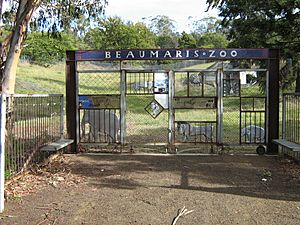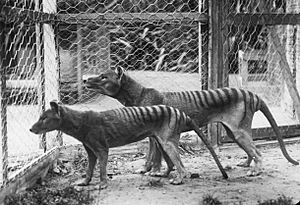Hobart Zoo facts for kids

The gates to the old Beaumaris Zoo site. Some of the remains of the original zoo can be seen in the background on the right.
|
|
| Date opened | 1895 (as Beaumaris Zoo) 1923 (at the quarry site) |
|---|---|
| Date closed | 1937 |
| Location | Hobart, Tasmania, AUS |
| Land area | 2 ha (4.9 acres) |
| Coordinates | 42°52′03″S 147°20′00″E / 42.8675°S 147.3334°E |
The Hobart Zoo, also known as Beaumaris Zoo, was a special animal park in Hobart, Tasmania, Australia. It was located on the Queens Domain, near the Governor's House and the Botanical Gardens. Today, the area is mostly a storage depot for the Hobart City Council. But you can still find some old parts and clues from the original zoo! The zoo had beautiful gardens and amazing views of the River Derwent.
Contents
The Famous Thylacine
The Hobart Zoo is most famous for one special animal: the Tasmanian tiger. This zoo is where the very last known living Tasmanian tiger was filmed in 1936. Sadly, this thylacine died at the Hobart Zoo on September 7, 1936.
To remember this important event, Australia now celebrates National Threatened Species Day every year on September 7. It's a day to think about all the animals that are in danger of disappearing forever.
History of the Zoo
The zoo first opened in 1895 and was called Beaumaris Zoo. It was located at the private home of a well-known Hobart lady named Mary Grant Roberts. Mrs. Roberts ran the zoo herself from 1895 until she passed away in 1921.
Her zoo was special because it helped people see native Australian animals, like the Tasmanian devil, in a new way. She even had a program to help Tasmanian devils have babies. Scientists also became very interested in the animals she cared for.
The Zoo Moves to a New Home
After Mrs. Roberts died, her family offered all the animals from Beaumaris Zoo to the Hobart City Council. In January 1922, the Council agreed to take the animals, but only if the Tasmanian State Government helped pay for the zoo. The government agreed to give £250 each year for the new zoo.
In March 1922, the Hobart City Council looked for someone to manage the animals. They chose Arthur Reid to be the curator, which is like the main manager, for the new zoo. Arthur Reid was born in Edinburgh, Scotland, and had loved nature since he was a boy. He moved to Tasmania when he was 21 and was especially good at raising pheasants and English birds.
Arthur Reid visited other zoos in Australia, like Taronga Park Zoo and Melbourne Zoo, to learn how to design animal homes and manage a zoo. He also planned to trade animals and birds with these zoos. While he was away, workers started building a new fence around the chosen spot for the new zoo.
Animals at the New Zoo
Sadly, some animals from Mrs. Roberts' original collection were lost before the Council took over. The Tasmanian devils, which were a big part of the old zoo, were no longer there. Only one thylacine was left, and it had been sick but was getting better thanks to Arthur Reid. The zoo was promised new Tasmanian devils. Other animals like wallabies, kangaroos, possums, and many kinds of birds were reported to be healthy.
In July 1922, there were some concerns about the animals at Mrs. Roberts' old property. Arthur Reid reported that the Tasmanian devils had been removed before the Council took over. He also said an old wallaby had died, and the thylacine had not had a mate for over two years. There were no wombats, and a squirrel had been alone for 18 months. He also had to put down a 'native cat' (quoll). By April 1922, there were 54 animals and 100 birds in the collection.
Later that year, a large wedgetail eagle that had been caught in a rabbit trap was sent to the zoo. It was cared for by Curator Reid. In September, people from the public donated a pair of Tasmanian devils and some possums to the future zoo.
By October, the new zoo site was almost ready. The boundary fence was finished, and a large pond for water birds was nearly done. Animal enclosures and bird aviaries were also close to completion, though some parts were delayed because of a shortage of wire netting. African lions were donated by Taronga Park Zoo. More animals like an echidna, wallabies, possums, eagles, and Tasmanian devils were also given to the zoo by the public.
Sadly, the last thylacine from Mrs. Roberts' collection died in mid-October from pneumonia. Its body was preserved for future display. After this loss, the Hobart City Council asked the public for another live thylacine for the zoo.
Building the New Zoo
By November, the zoo's construction was almost finished. The site was fully fenced, and the aviaries and enclosures were nearly ready for many animals, including deer, emu, ostrich, and peafowl. A special terraced enclosure for the African lions was being built into the hillside. It was designed so visitors could see the lions from above and below, with a moat in front and strong concrete walls.
A large, figure-eight shaped pond, 300 feet around, was a new feature for aquatic birds. An arched bridge was also planned for the pond. Trees, shrubs, and flower beds were being planted all around the site. The Council also planned to build an office, a store, a tea house, and public restrooms.
On November 29, the Tasmanian Legislative Council officially allowed the Hobart City Council to "establish and maintain zoological gardens to be known as the Beaumaris Zoo." This meant the Council could spend money to keep the zoo running.
Opening Day in 1923
By the end of January 1923, the new zoo was ready! The animals were moved from the old Beaumaris property to the new location on the Queens Domain on February 1, 1923. However, an old kangaroo died shortly after arriving at the new site. The African lions from Taronga Park Zoo had not yet arrived for the opening.
The official opening ceremony took place on Friday, February 2, 1923. Alderman Williams led the ceremony because the mayor was not there. Ida Roberts, Mary Grant Roberts' daughter, who had donated the original animal collection, was also at the opening of the new Beaumaris Zoological Gardens. When it opened, the zoo had 100 animals and 220 birds.
On opening day, the two Tasmanian devils that had been given to the zoo escaped from their enclosure! They were later found hiding under a culvert (a drainpipe). The zoo staff tried to catch them, but the marsupials were too quick. Finally, on February 17, Curator Reid built a special box trap with lamb's heart as bait. He left it near where the devils were hiding, and they were successfully recaptured.
The gate that stands at the zoo site today was put in place on September 9, 2000, which is World Threatened Species Day. It was designed to tell people about the history of the site and keep it secure. It even won an award in 2001 for its landscape design.
Zoo Closure
The Hobart Zoo closed in 1937 because it had serious money problems. After it closed, the Royal Australian Navy took over the site. They turned it into a fuel storage depot for their nearby naval base, HMAS Huon. The Navy used the site from 1943 until 1991. Then, it went back to the Hobart City Council, who used it as a storage depot.
The Future of the Site
In 1967, a plan called The Beaumaris zoo site conservation plan was published. People have suggested different ideas for what the site could be used for in the future. Some ideas include a sculpture park for Tasmanian artists or a wildlife rehabilitation center. There have also been talks for several years about building a new zoo. The property is considered a "national treasure" and a "special place in the state's history." In 2019, it was put up for sale.



